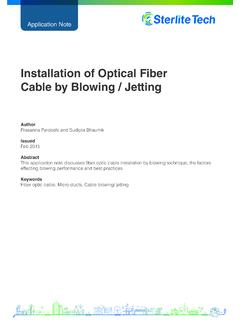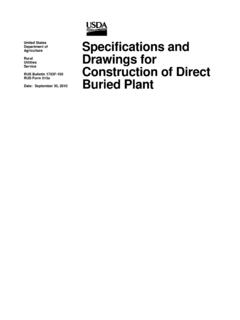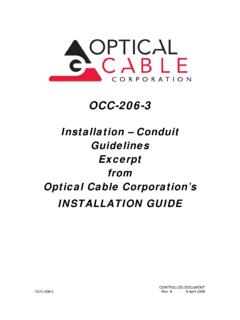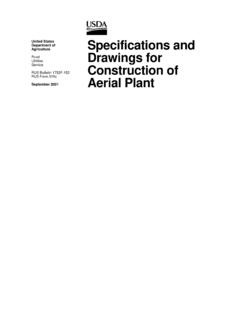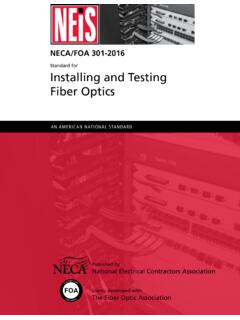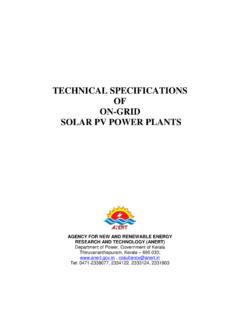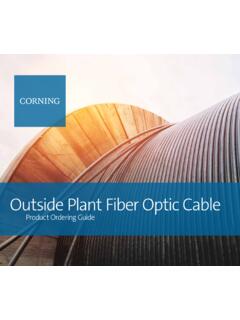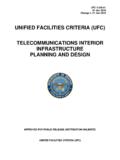Transcription of Aerial Cable Placing Procedure - STL
1 IssuedNovember Sterlite is a registered trademark of Sterlite Technologies LimitedAbstractAn Aerial Cable is an insulated Cable usually containing all fibres required for a telecommunication line, which is suspended between utility poles or electricity pylons. Aerial optical cables are available in a variety of designs to suit every overhead application. Aerial Cables are supplied as self-supporting including non-metallic ADSS variants, figure 8 which includes an independent catenary wire or cables which can be lashed to existing overhead catenaries. This document describes the most preferred methods for Aerial installation. ADSS, Fig 8, Micro ductKeywordsAerial Fiber Cable Placing MethodsApplication Note Sterlite is a registered trademark of Sterlite Technologies LimitedApplication Note 1.
2 Table of Contents2 Introduction3 General4 Precautions Cable Handling LED and Laser Precaution Optical Fiber Handling Precautions Material Safety Safety During Installation Personal Protective Equipment Traffic Safety Placing Equipment Cable Protection and Reel Handling5 Preparation for Cable Placing Pre-Construction Survey Pre-Construction Fiber Measurements6 Unique Aspects of the Messenger Strand (Suspension Strand)7 Tools and Materials8 Types of Aerial Plant Aerial Cable Lashed to a Messenger Strand Messenger Strands Moving Reel Method Stationary Reel Method Cable Lashing Self-Supporting Cable Figure-Eight Cable Dead-Ends All-Dielectric Self-Supporting (ADSS) Cable Micro-duct Cable used in Aerial plant Micro-Ducts Micro-Duct Cables Jetting: Micro-Duct Cable Placing Method Micro-Duct Cable Sterlite is a registered trademark of Sterlite Technologies LimitedApplication Note 2.
3 IntroductionThis practice covers the basic guidelines for installation of Aerial fiber-optic Cable . It is intended for personnel with prior experience in planning, engineering, or placement of Aerial Cable . Pole line construction and strand installation are not covered in this document. A working familiarity with Aerial Cable requirements, practices, and work operations is necessary as this guide does not cover all aspects of Aerial construction work. Aerial optical Cable is suspended in the air from poles and/or support structures. Most often it is supported between poles by being lashed to a wire rope messenger strand with a small gauge wire. The strand is tensioned to satisfactorily withstand the weight of the Cable for the span length it will be used on plus any climatic loading such as ice, snow, and wind. The objective is to keep the Cable in as low a state of stress as possible while maintaining sag in the messenger and Cable that is safe and within limits as prescribed.
4 Figure 1 Sterlite Duct-Lite Optical Cable for Lashed Aerial ApplicationsSome cables carry their own messenger and get their name from their shape, Figure-Eight Cables. The messenger is in the top portion of the figure-eight which has an extruded over jacket. The Cable is supported from the messenger portion of the Cable with a thin plastic web. As with the lashed Cable , the messenger must be properly tensioned to resist the expected loading while keeping sag between supports safe and within acceptable limits. Figure 2 Sterlite Loose Tube Figure-Eight Optical Cable for Aerial ApplicationsThe next type of Aerial Cable is an All-Dielectric Self-Supporting (ADSS) Cable with extra aramid yarn to provide its own support, eliminating the need for a messenger strand. ADSS Cable is often used to span large distances when being supported off power utility towers. It is also popular when used near power utility lines as distribution Sterlite is a registered trademark of Sterlite Technologies LimitedApplication Note The final optical Cable covered in this document is a small diameter micro-duct Cable , Micro DUCT-LITE Optical Cable .
5 It has a cross-sectional diameter in the range from ( mm) to ( mm) for cables ranging from 12 to 288 fibers. Its cross-section consists of between 1 and 24 loose buffer tubes wrapped around a dielectric central strength member (CSM). It is an all dielectric Cable so bonding and grounding issues are more relaxed. In its present configuration, it has a dry core and wet buffer tubes (filled with thixotropic water blocking gel). Figure 3 Sterlite Aerial -Lite (ADSS) Optical Cable for Aerial ApplicationsFigure 4 Cross-Section of Sterlite's Micro DUCT-LITE Multitube Fiber Optic CableAs is shown in Figure 5, a micro-duct Cable provides a more compact packing for the fiber in a Cable half the weight of a conventional optical Cable . Figure 5 Comparison of Sterlite's Micro-Duct Optical Cable to a 72 Fiber Conventional Optical Sterlite is a registered trademark of Sterlite Technologies LimitedApplication Note Sub-ducts and micro-ducts are not used too frequently in Aerial installations, but they are used occasionally when the Placing operation cannot interrupt surface traffic or extra protection is required for the Cable .
6 Micro-duct Cable is blown (jetted) into the micro-duct. Normally, standard size fiber optic cables can be pulled or blown into short lengths of Aerial inner most common OSP uses of the different Aerial Cable designs are shown in Table PlantMessenger StrandMicro-DuctsCampusesUrbanNewSuburba nOldSuburbanRuralTable 1 Commonly Used Aerial Plant Types for Various OSP Applications= Used often in this application= Can be used in the application under certain circumstancesFigure 8 ADSS3. GeneralThe Aerial Placing methods described in this document are intended as guidelines. National, state, local, corporate regulations and industry recommendations normally take precedence over the procedures contained herein. It is impossible to cover all the conditions that may arise during a Placing operation. Individual company practices for Placing fiber optic Cable should supersede any conflicting instructions in this document whenever they do not exceed the Cable 's optical and mechanical performance specifications.
7 In addition, instructions provided by hardware manufacturers should be methods used to place Aerial fiber optic cables are similar to those used to place copper Cable . Optical Cable is a high capacity transport medium that is sensitive to excessive tensile force, tight bends, and crushing forces, therefore, some care must be taken during the installation Procedure to respect these limitations. Fiber optic cables are ordered in lengths as calculated by an OSP ( outside plant ) Engineer to match the service route they will occupy. Their lengths are determined by measuring the distance between the splice points plus adding the excess length to reach the two splice locations and make the splices, and the required slack storage length for maintenance. In addition, extra length should be included in the ordered length to be available to cover errors are made during the splicing operation. If the excess splice length is not known, the splicing foreman should be consulted.
8 Never cut a fiber Cable without first consulting the OSP Engineer responsible for the Sterlite is a registered trademark of Sterlite Technologies LimitedApplication Note PrecautionsCable bending radius: Optical fiber cables are designed with a minimum bending radius and maximum tensile strength. The Cable should never be bent below its minimum bending radius. Doing so can result in bending losses and/or breaks in the Cable 's fibers. Generally the minimum bending radius of a fiber Cable under load is 20 D, where D is the diameter of Cable ; the minimum bending radius of a fiber Cable under no load is 15 Placing Tension: Optical cables are designed with a maximum tensile strength. The Cable should never be loaded beyond its maximum tensile strength. Exceeding this value provided by Sterlite in the Cable Data Sheet / Specification, can alter Cable and fiber performance and shorten its service Cable HandlingAll optical cables are sensitive to damage during shipping, handling, and installation.
9 Some of the important parameters that need special attention during Cable installation Optical Fiber Handling PrecautionsBroken fiber ends created during termination and splicing can be dangerous. These ends are sharp and can easily penetrate the skin. They invariably break off and are very hard to find and remove. Often tweezers and a magnifying glass are needed to remove them from the skin. Any delay in their removal could lead to an infection. Hence,Be careful while handling of all fiber scraps safely and not eat or drink near the splicing LED and Laser PrecautionLEDs and lasers are used to test fiber and transmission systems. They emit beams that are invisible to the human eye that can seriously damage the eye. Viewing these beams directly may not cause any pain and the iris may not close automatically as it would while viewing a bright light. As a result, the eye may not react to protect itself, resulting in increasing the chance of serious damage to the ,Never look directly into a fiber end that has a laser or LED coupled to look directly into a fiber end using any magnifying an eye is accidentally exposed to an LED or laser beam, immediately seek medical Sterlite is a registered trademark of Sterlite Technologies LimitedApplication Note Material SafetyFiber optic splicing and termination processes often use various chemical cleaners.
10 The safety instructions developed for these substances should be followed. If there is confusion in the usage of these products, ask their manufacturer for a Material Safety Data Sheet (MSDS). Remember the following instructions while working with these work in well-ventilated skin contact with these cleaning materials as much as using chemicals that causes allergic alcohol, used as a cleaner, is flammable and should be handled 2- Primary Treatments for Hexane and Isopropyl ExposureDo not induce vomiting, immediately seek medical off affected area and wash with soap and eyes with plenty of water for 15 ofthe upper respiratory victim to area containing fresh air. Administer artificial respiration if breathing is TreatmentHexaneMaintain respiration, bed of ExposureType ofExposureIrritation of the respiratory tract, ,Vomiting, with EyesContact with SkinDrunkenness and to victim drink water and milk.
